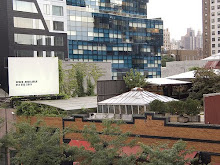


1) Robert F. Kennedy touring Bed-Stuy, 1966 (Robert McMahan Photography archive). 2) Do the Right Thing’s character Radio Raheem on Stuyvesant Ave, 1989 (Groucho reviews). 3) Trendy Lewis Avenue to the west of Stuyvesant Ave, 2009 (NY Times Real Estate Section).
Spike Lee filmed one of his most critically acclaimed films on our first site. This site, which comprises of the one block of Stuyvesant Street between Lexington and Green Avenue, in Bedford-Stuyvesant, Brooklyn was immortalized in the 1989 classic Do the Right Thing. The film follows the events of the hottest day of the summer on one block in Bed-Stuy, a predominantly black neighborhood. The film exposes the palpable racial tensions of this neighborhood amongst Black, White, Puerto Rican, and Korean populations. The racial tensions escalate to a fight at the end of the film resulting in the death of black character, Radio Raheem, at the hands of an Italian pizza owner. In response to this senseless death, community members riot and destroy the pizza parlor. Many argue that this destruction of property symbolizes the tension between non-violent and violent approaches to resistance within the black community. We would argue instead that this destruction of physical property symbolizes the destruction of the property of whiteness. It is a response to the continued privilege given to whiteness in the forms of segregation, education, and resources.
This site is important in the workings of race, power, and inequality not only because it was the location of such a pivotal film concerning this struggle, but also its role in the real Bedford-Stuyvesant - a historically significant area to black history. It was the second largest community of African American in Northeast, after Harlem, in the early 21st century. In 1936, the two communities were connected by the independent subway rail – the A train – making Bed-Stuy accessible to Manhattan to one another. From then into the 1950’s, increasing racial segregation practices coupled with white flight to suburbs resulted in the further disenfranchising of black urban America. As one of the nation’s largest ghettos by the mid 1960’s, Bed-Stuy was an embodiment of this inequality. Racial tensions were coming to a head by then with the help of the civil rights movement and there was a national call to act. In response to that call in 1966, Senator Robert F. Kennedy came to tour Bed-Stuy to see for himself the devastating conditions of black poverty in his state. Four blocks to the west of our site, you can find Public School 305 where on December 10, 1966, Senator Kennedy gave a speech bringing national attention to the plight of Bed-Stuy and the greater minority community. There he created the Bedford-Stuyvesant Restoration Corporation to help address these issues.
This corporation did little, however, to lift the community out of racialized poverty throughout the 1970’s or 80’s. When Do the Right Thing was shot on this street twenty years ago in 1989, the community was still primarily black and poor. Racial tensions then were running high in NYC as it was emerging from an era of crime and aggressive, corrupt policing under mayor Ed Koch, racial hate crimes like 1986’s Howard Beach incident and entering one that began with the campaign of the first Black mayor, David Dinkins. Bed-Stuy, as an integral part of the city’s racial identity, was a perfect site for Lee’s film on race and power.
The brownstone buildings that lined the street twenty years ago are still there today with local businesses on all corners of the intersection. The large mural seen in the film on corner of Stuyvesant and Greene Avenues is no longer there, replaced with faint remnants of another image. According to a New York Times article this summer, the area is increasingly more attractive to young professionals. Stuyvesant Avenue is a brownstone block and part of the architecturally charming Stuyvesant Heights Historic District. With commercially developed and quant Lewis Avenue only a block to the west, this area is beginning to experience a displacement of their community similar to the experiences due to gentrification described in Davila’s book. The Pratt Area Community Council’s sole job is deal with displacement in this neighborhood. This site is not only the host of one of the worst important films to explore the workings of race, space, and inequality, but is in itself, a study of such a struggle.
Stuyvesant Ave between Lexington and Greene
Take the A subway train to Utica Ave.
Exit near Fulton St
Start out going East on Fulton St towards Stuyvesant Ave
Turn left onto Stuyvesant Ave
Sources
Do the Right Thing. Dir. Spike Lee. Universal, 1989. DVD.
Echanove, Matias. "Bed-Stuy on the Move: Demographic Trends and Economic Development in the heart of Brooklyn." Thesis. Columbia University, 2003. Http://www.urbanology.org/BedStuy/. 2003. 5 Dec. 2009.
Massey, Douglas S., and Nancy A. Denton. American Apartheid. Cambridge: Harvard UP, 1993.
Ment, David, and Mary S. Donovan. The People Of Brooklyn. Brooklyn: Brooklyn Educational and Cultural Alliance, 1980.
Omi, Michael, and Howard Winant. Racial Formation in the United States. New York: Routledge, 1994.
Rusk, David. Inside Game Outside Game. Washington D.C.: Brookings Institution P, 1999.
Vandam, Jeff. "History, With Hipper Retailing in Bed-Stuy." New York Times 21 Aug. 2009. 7 Dec. 2009

No comments:
Post a Comment